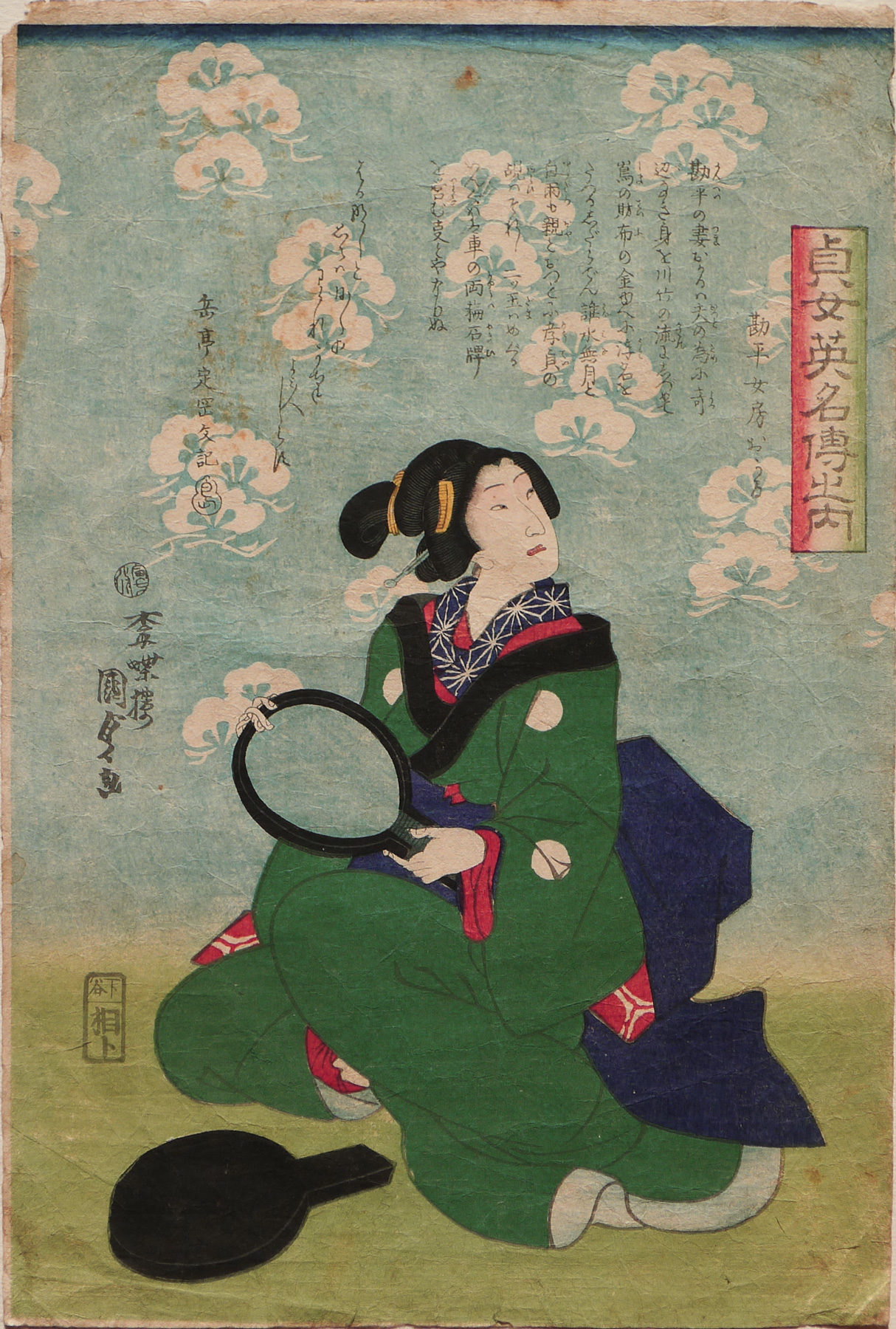About This Print
This print pictures the character Okaru, the wife of Hayano Kanpei from the play Kanadehon Chūshingura (TheTreasury of Loyal Retainers, a.k.a. The Forty-Seven Ronin), based on the Akō Incident (1701-1703) in which forty-seven retainers of Lord Asano (the character Enya Hangan in the play) take revenge against the shogun's court official Kira Yoshinaka (the character Ko no Moronao in the play), whose actions caused the death of their lord. The Museum of Fine Arts, Boston identifies the actor in the role of Gihei as Kawarazaki Gonjūrō I, although the actor's name does not appear on the print.The multi-colored cartouche gives the name of the series as Stories of Virtuous Women and the name of the character portrayed is given to the immediate left of this cartouche, in this case Kanpei's wife 勘平女房. The background script may provide an account of Okaru's role in the play or actual lines spoken by the character.
To read more about the representations of Chūshingura in woodblock prints see the article on this site Chūshingura (The Treasury of Loyal Retainers) in Woodblock Prints.
Okaru, Wife of Kanpei
The theatrical adaptation of the Akō Incident, Kanadehon Chūshingura or simply Chūshingura, combined historical characters from the Akō Incident, assigning them thinly disguised fictitious names, along with unrelated historical characters and fictional characters, mostly added to spice up the play with erotica.
Three Related Series
Note: Please reference the images under "Three Related Series" on the page for the print Ōboshi Yuranosuke (IHL Cat. #630) for the below discussion.
The Actual Events: The Akō Incident (1701-03)
The so-called Akō Incident began on April 21, 1701, when the lord of Akō, Asano Naganori, drew his sword in a corridor of Edo Castle and slashed the senior bakufu protocol official, Kira Yoshinaka, in retaliation for a perceived slight. While Kira suffered only a light wound, Asano was arrested and ordered to commit seppuku later the same day, largely for drawing his sword in the Castle. His estate was confiscated and dissolved leaving his retainers without jobs, or as ronin. Forty-seven of these ronin signed an oath to avenge their lord by killing Kira and twenty-one months later attacked his Edo mansion, took his head, and marched across the city to the temple of Sengakuji, where they placed it before the grave of their master and surrendered. After almost two months of debate, the bakufu ordered the seppuku of the ronin and on March 20, 1703 they committed ritual suicide. Their ashes were interred at Sengakuji.Okaru, Wife of Kanpei
The theatrical adaptation of the Akō Incident, Kanadehon Chūshingura or simply Chūshingura, combined historical characters from the Akō Incident, assigning them thinly disguised fictitious names, along with unrelated historical characters and fictional characters, mostly added to spice up the play with erotica.Source: Columbia University website http://www.columbia.edu/~hds2/chushinguranew/kanadehon/okaru.html
Okaru's name immediately associates her with the mistress, also named Okaru, that Kuranosuke took up residence with while living in Yamashina. However, aside from her presence at the teahouse Ichirikiya and Yuranosuke's brief feint at courting her, there are few, if any, comparisons, thematic or otherwise, to draw between the two. It is safe to say that, while the name may have been chosen for the historical resonance it brought to the text and the character, the two Okarus represent two distinctly different personas.
If Hayano Kanpei is someone who is inadvertently tempted by passion to commit a transgression against his lord, then it is Okaru who performs the role of the temptress. She is the central female character in a play that, more often than not, portrays women as nothing better than mere obstacles to samurai duty and virtue. And while it might be anachronistic and heavy-handed to judge Chūshingura as misogynistic, Okaru, through her actions and influence, without a doubt achieves much the same textual status that Eve does in the Old Testament version of Genesis.
Variant Edition
Print Details
| IHL Catalog | #960 |
| Title/Description | Kanpei's Wife (Okaru) 勘平女房 |
| Series | Stories of Virtuous Women (Teijo eimeiden no uchi 貞女英名伝之内) |
| Artist | Utagawa Kunisada II (1823-1880) |
| Signature |  |
| Seal | None |
| Publication Date |  |
| Publisher |  |
| Impression | excellent |
| Colors | good |
| Condition | poor - extensive wrinkling thoughout, soiling throughout |
| Genre | ukiyo-e; yakusha-e |
| Miscellaneous | |
| Format | Vertical Oban |
| H x W Paper | 14 5/8 x 9 3/4 in. (37.1 x 24.8 cm) |
| H x W Image | 14 1/4 x 9 5/8 in. (36.2 x 24.4 cm) |
| Collections This Print | |
| Reference Literature | |



